Foureye Butterflyfish
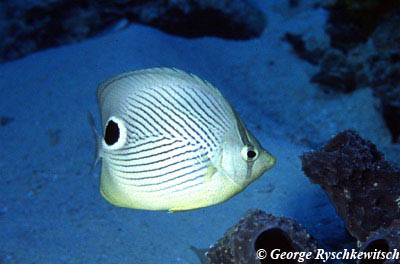
Chaetodon capistratus
This small, flat fish is named for the spots on its tail that look like eyes, and are meant to confuse predators about the fish’s direction of fleeing. The foureye is pale gray with dark chevrons pointing towards its head, and has bright yellow caudal fins. This is one of the few fish that seems to mate for life. They’re also well known for their swimming capabilities, maneuvering through coral reefs with ease, even swimming sideways or upside down.
Order – Perciformes
Family – Chaetodontidae
Genus – Chaetodon
Species – capistratus
Common Names
Foureye butterflyfish (English), butterbun (English), butterfly (English), katy (English), school mistress (English), kete (English), macamba (Papiamento), macamba calaberde (Papiamento), macamba marinier (Papiamento), macamba ulandes (Papiamento), marguerite (French), mariposa (Spanish), parche (Spanish), parche ocelado (Spanish).
Importance to Humans
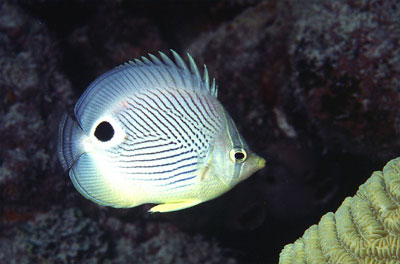
The foureye butterflyfish is harvested for the aquarium trade since its small size and attractiveness makes it an ideal aquarium fish, even if its particular diet make feeding somewhat difficult. The foureye is a shy fish and generally retreats if approached by a diver.
Conservation
> Check the status of the foureye butterflyfish at the IUCN website.
The IUCN is a global union of states, governmental agencies, and non-governmental organizations in a partnership that assesses the conservation status of species.
Geographical Distribution

The foureye butterflyfish is a very common butterflyfish in the tropical western Atlantic. It ranges along the North and South American coasts from Massachusetts to Brazil, including the Gulf of Mexico and the Caribbean.
Habitat
This subtropical fish inhabits shallow coral reefs and related inshore habitats such as sea grass beds, at depths of 6-65 feet (2-20m). Juveniles are more commonly found in seagrass beds. Juveniles are common in very shallow areas, like a grass bed or a shallow reef, and generally are associated with some particular shelter, like a coral head or a rock, where potential food sources like algae and encrusting invertebrates can grow. Adult foureye butterfly fish live primarily in pairs, while the young are usually solitary. If an adult pair gets separated, a partner makes an effort to find and rejoin its partner.
The foureye butterfly is a diurnal species, active during the day and sleeping at night. This behavior makes the foureye vulnerable to night predators like the moray eel and various sharks. The foureye seeks shelter at the end of the day in order to rest and to hide from any possible predators.
Biology
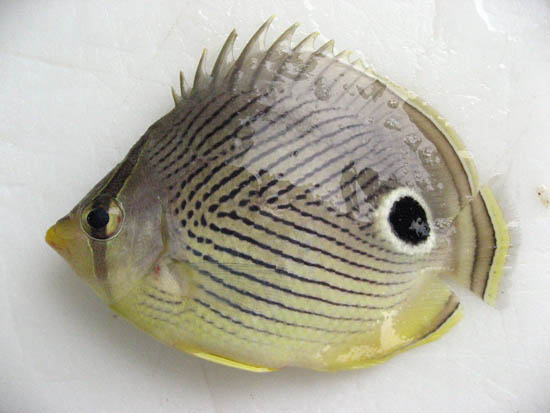
Distinctive Features
This is a compressed, discus-shaped fish with a concave forehead. This body plan gives the fish great maneuverability, allowing it to negotiate the coral reefs and the sea grass beds that it inhabits. It has a small, projectile mouth with a short snout. There are prominent spines on the dorsal and anal fins.
Coloration
The foureye gets its name from the large, dark spot on the rear portion of the body, surrounded by a brilliant white ring. This spot acts as a false eye. A black, vertical bar on the head runs down the true eye, making it less visible. This may result in a predator confusing the rear end of the fish for the front end. The adult foureye has a white body marked with numerous dark, thin lines that radiate diagonally from the mid body to the top and the bottom of the fish. It is the only butterfly species in the area with these converging lines along the side of the body.
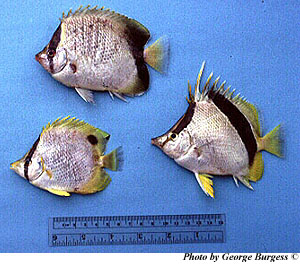
Size, Age, and Growth
Adults may reach 6 inches (15 cm) in length, but are more common at lengths of less than 4 inches (10 cm). Sexual maturity is reached at approximately 3.5 inches (9 cm) in length.
Food Habits
During the day it feeds on small invertebrates. Its small, projectile mouth makes it adept at crevice feeding, where some of its food likes to hide. The bristle-like teeth, arranged in narrow bands in the jaws, are useful for scraping and nipping attached invertebrates, mainly zoantharians, polychaete worms, gorgonians and tunicates, that make up its diet.
Reproduction
Male and female foureye butterflies form pairs early in life. These pairs can be long lasting, suggesting that a monogamous relationship may exist between the pair members. If the two fish get separated, one partner will swim upward for a better view in an effort to rejoin the other partner. Courtship between the two is prolonged and energetic. Often the fish will circle each other, head to tail, until one fish breaks and runs, with the other close behind. They will chase each other all about the reef, and chase away any lone foureye that approaches them. Actual spawning takes place at dusk. The female releases from 3000 to 4000 eggs a night. The eggs are small, pelagic, and hatch within a day. The larvae, called tholichthys, are characteristic only of the butterflyfish family. This life stage is very distinctive: the head is encased in bony armor and bony plates extend backwards from the head. The tholichthys are silvery grey in color and almost transparent, useful adaptations for and species living in the water column. They settle on the bottom during the night after they reach 20mm. Sometimes thousands of tholichthys settle all in the same night, making a smorgasbord for bottom dwelling organisms. Transformation is so rapid that by the morning the tholichthys larvae already resemble the juvenile stage in respect to color.
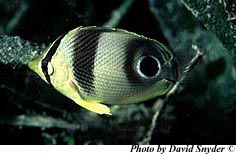
In addition to moray eels and sharks, foureye butterflyfishes are consumed by a variety of other large fish. The foureye’s first instinct when threatened is to flee, putting the false eye spot closer to the predator than the head. Most predators aim for the eyes, and this false eye spot tricks the predator into thinking that the foureye will flee tail first. When escape is not possible, the foureye sometimes turn to face its aggressor, head lowered and dorsal and anal spines fully erect, like a bull about to charge. This may serve to intimidate the other animal or may remind the predator that the butterfly is much too spiny to consume.
Taxonomy
The foureye butterflyfish was first described by Linnaeus in 1758, who named it Chaetodon captistratus. Smith (1897) described and named another species Chaetodon bricei, which was later acknowledged as juvenile C. capistratus after the life history of this fish was better understood. Another synonym is Sarothrodus capistratus Poey 1868. The name “Chaetodontidae” means “bristle-tooth” (“Chaeto” = bristle and “donte” = tooth), describing the teeth found in this family.
Prepared by: Casey Patton